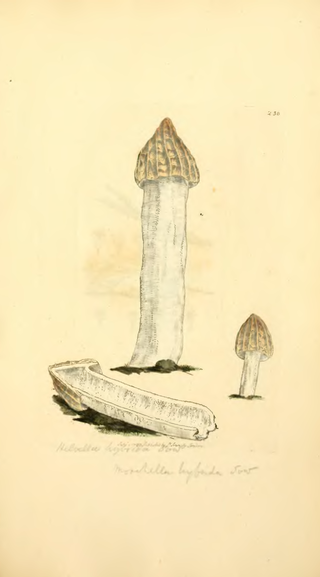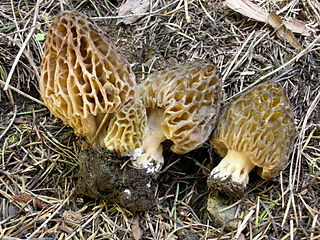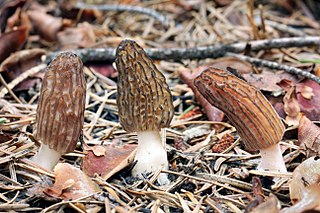
Morchella, the true morels, is a genus of edible sac fungi closely related to anatomically simpler cup fungi in the order Pezizales. These distinctive fungi have a honeycomb appearance due to the network of ridges with pits composing their caps. Morels are prized by gourmet cooks, particularly in Catalan and French cuisine. Due to difficulties in cultivation, commercial harvesting of wild morels has become a multimillion-dollar industry in the temperate Northern Hemisphere, in particular North America, Turkey, China, the Himalayas, India, and Pakistan where these highly prized fungi are found in abundance.

Morchella esculenta is a species of fungus in the family Morchellaceae of the Ascomycota. It is one of the most readily recognized of all the edible mushrooms and highly sought after. Each fruit body begins as a tightly compressed, grayish sponge with lighter ridges, and expands to form a large yellowish sponge with large pits and ridges raised on a large white stem. The pitted yellow-brown caps measure 2–7 centimetres broad by 2–10 cm (1–4 in) tall, and are fused to the stem at its lower margin, forming a continuous hollow. The pits are rounded and irregularly arranged. The hollow stem is typically 2–9 cm long by 2–5 cm (1–2 in) thick, and white to yellow. The fungus fruits under hardwoods and conifers during a short period in the spring, depending on the weather, and is also associated with old orchards, woods and disturbed grounds.

Morchella elata is a species of fungus in the family Morchellaceae. It is one of many related species commonly known as black morels, and until 2012 the name M. elata was broadly applied to black morels throughout the globe. Like most members of the genus, M. elata is a popular edible fungus and is sought by many mushroom hunters.

Verpa bohemica is a species of fungus in the family Morchellaceae. Commonly known as the early morel or the wrinkled thimble-cap. The mushroom has a pale yellow or brown thimble-shaped cap—2 to 4 cm in diameter by 2 to 5 cm long—that has a surface wrinkled and ribbed with brain-like convolutions. The cap hangs from the top of a lighter-colored, brittle stem that measures up to 12 cm long by 1 to 2.5 cm thick. Microscopically, the mushroom is distinguished by its large spores, typically 60–80 by 15–18 µm, and the presence of only two spores per ascus.

Morchella rufobrunnea, commonly known as the blushing morel, is a species of ascomycete fungus in the family Morchellaceae. A choice edible species, the fungus was described as new to science in 1998 by mycologists Gastón Guzmán and Fidel Tapia from collections made in Veracruz, Mexico. Its distribution was later revealed to be far more widespread after several DNA studies suggested that it is also present in the West Coast of the United States, Israel, Australia, Cyprus, Malta and Switzerland.

Morchella semilibera, commonly called the half-free morel, is an edible species of fungus in the family Morchellaceae native to Europe and Asia.

Morchella tridentina is a cosmopolitan species of ascomycete fungus in the family Morchellaceae. Commonly referred to as the mountain blond or western blond morel in North America, it produces conical, grey to buff fruit bodies that are rufescent and grow up to 20 cm (7.9 in) tall and 5 cm (2.0 in) wide. This early-diverging species is distinct within the /Elata clade due to its pale colours and has been described by many names in the past, including M. frustrata, M. quercus-ilicis, M. elatoides, M. elatoides var. elegans and M. conica var. pseudoeximia, all of which were shown to be synonyms. A widely distributed relict of the last Ice Age, M. tridentina is so far known from Argentina, Armenia, Chile, Cyprus, France, India, Israel, North America, Spain and Turkey.
Morchella ulmaria is a species of fungus in the family Morchellaceae. It was described as new to science in 2012 by Philippe Clowez. Later in the same year, Michael Kuo and colleagues described Morchella cryptica, which is a junior synonym of M. ulmaria. The species occurs in the forests of Midwestern North America, often associated with white ash, the American tulip tree or species of maple or elm. It is closely related to M. castanea and 2 unnamed species from Asia.

Morchella americana is a North American species of fungus in the family Morchellaceae.

Morchella snyderi is a species of fungus in the family Morchellaceae. Described as new to science in 2012, it occurs in the montane forests of western North America, including California, Idaho, Montana, Oregon and Washington. It produces fruit bodies up to 14 cm (5.5 in) tall with ridged and pitted conical caps, and stipes that become pitted in maturity. The color of the morel is yellow to tan when young, but the cap ridges become brown to black in maturity or when dried.

Morchella importuna is a species of fungus in the family Morchellaceae described from North America in 2012. It occurs in gardens, woodchip beds, and other urban settings of northern California and the Pacific Northwest region of the United States and Canada. The fungus has also been reported from Turkey, Spain, France, Switzerland, Canada and China, although it is unknown whether this is a result of accidental introductions. It is considered a choice edible mushroom. The fruit bodies develop a distinctive ladder-like pattern of pits and ridges on the surface of their conical caps.
Morchella capitata is a later synonym of Morchella exuberans. Originally identified as phylogenetic species Mel-9, it was described as new to science in 2012 by Kuo and colleagues. In 2014 however, Richard and colleagues clarified the taxonomic status of this species, retaining the name Morchella exuberans of Clowez (2012) over M. capitata.

Morchella septimelata is a species of fungus in the family Morchellaceae described as new to science in 2012. Occurring in western North America, it has been collected from British Columbia, Montana and Oregon, where it fruits at elevations of 1,000 to 2,000 m in coniferous forests in years following slight to moderate burning.

Morchella sextelata is a species of ascomycete fungus in the family Morchellaceae. Described as new to science in 2012, it is found in North America. It has also been found in China, although it is not known if this is a result of an accidental introduction or natural dispersion. The fruit bodies have a roughly conical cap up to 7.5 cm (3 in) tall and 5 cm (2 in) wide, with a surface of mostly vertically arranged pits. The cap is initially yellowish to brownish, but it darkens to become almost black in maturity. The stipe is white and hollow, measuring 2–5 cm (0.8–2.0 in) high by 1–2.2 cm (0.4–0.9 in) wide.

Morchella populiphila is a species of morel fungus native to northwestern North America. Described as new to science in 2012, its specific epithet refers to its association with black cottonwood. The morel used to be referred to as Morchella semilibera in western North American field guides until molecular analysis established that to be a strictly European species. M. populiphila occurs in California, Nevada and Oregon. Its fruit bodies grow up to 15 cm (6 in) tall with a ridged and pitted conical cap that attaches about halfway down the stipe. The cap ridges are dark brown to black in maturity, while the pits are yellowish to brownish. The fungus is edible, although not as highly valued as other morels.

Morchella punctipes is a species of morel fungus in the family Morchellaceae. It is native to North America, found widely distributed east of the Rocky Mountains. It is edible when cooked.

Morchella angusticeps is a species of fungus in the family Morchellaceae native to eastern North America. Described by Charles Horton Peck in 1879, the name M. angusticeps was clarified in 2012 prior to which this species may have been referred to as either M. angusticeps or M. elata. M. angusticeps is one of the black morels, and is found in eastern North America, where it occurs in association with various hardwoods in the spring.

Morchella vulgaris is a widespread fungus of the family Morchellaceae (Ascomycota). It was originally described in 1801 as a form of the common yellow morel by mycologist Christiaan Hendrik Persoon, but was later recombined as a distinct species by Samuel Gray.
Morchella exuberans is a species of fungus in the family Morchellaceae (Ascomycota). It was described as new to science in a 2012 study by Clowez and corresponds to phylogenetic lineage Mel-9. Morchella capitata, described by Kuo and colleagues later in the same year, is a synonym of this taxon.

Morchella sceptriformis is a species of fungus in the family Morchellaceae (Ascomycota). It was described as new to science in a 2012 study by Clowez, and corresponds to phylogenetic lineage Mes-3. Morchella virginiana, described later in the same year by Kuo and colleagues, is conspecific to this taxon.

















